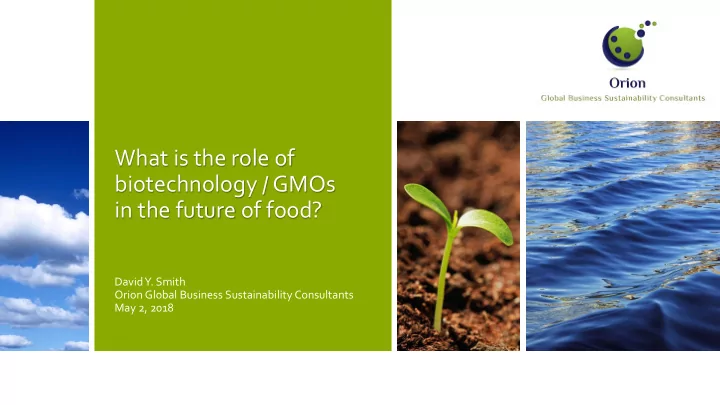

What is the role of biotechnology / GMOs in the future of food? David Y. Smith Orion Global Business Sustainability Consultants May 2, 2018
Food Security “De - couple” 80% Middle Class by 2030 McKinsey “Resource Revolution”: Beyond capital + 50% food production and labour efficiency to resource efficiency
The Case for Sustainability ? Agriculture today • Uses 70% of freshwater available • Most arable land already used Food Production by 2030 • 50% increase required • But 40% is wasted now
Seafood Sustainability – Why? Wild Seafood – Global Tonnage Plateau Since Late 1980s; Farmed is the Future Growth
Definition: Genetically Modified Organisms Genetic engineering , also called genetic modification or genetic manipulation , is the direct manipulation of an organism's genes using biotechnology. It is a set of technologies used to change the genetic makeup of cells, including the transfer of genes within and across species boundaries to produce improved or novel organisms. New DNA is obtained by either isolating and copying the genetic material of interest using recombinant DNA methods or by artificially synthesising the DNA. An organism that is generated through genetic engineering is considered to be genetically modified (GM) and the resulting entity is a genetically modified organism(GMO). The first GMO was a bacterium generated by Herbert Boyer and Stanley Cohenin 1973. Rudolf Jaenisch created the first GM animal when he inserted foreign DNA into a mouse in 1974. The first company to focus on genetic engineering, Genentech, was founded in 1976 and started the production of human proteins. Genetically engineered human insulin was produced in 1978 and insulin-producing bacteria were commercialised in 1982. Genetically modified food has been sold since 1994, with the release of the Flavr Savr tomato. The Flavr Savr was engineered to have a longer shelf life, but most current GM crops are modified to increase resistance to insects and herbicides. In 2016 salmon modified with a growth hormone were sold. Genetic engineering has been applied in numerous fields including research, medicine, industrial biotechnology and agriculture. In research GMOs are used to study gene function and expression through loss of function, gain of function, tracking and expression experiments. As well as producing hormones, vaccines and other drugs genetic engineering has the potential to cure genetic diseases through gene therapy. The same techniques that are used to produce drugs can also have industrial applications such as producing enzymes for laundry detergent, cheeses and other products. Source: Wikipedia 5 May 30, 2016
What are Canadians very concerned about? “I am personally concerned about” • Drug resistance due to farm animals given antibiotics • Use of hormones in farm animals • Drug residues in meat, milk, eggs • Use of pesticides in crop production • 41-46% Eating meat (incl. poultry) that comes from GE farm animals • Eating food from GE crops • I am more concerned about GE foods than I was 5 years ago Question: Please tell us how concerned you are about the Please rate the degree to which you agree or disagree with the following issues? % = Very Concerned following statements. % = Strongly Agree (Top Box (8-10) on 0 to 10 scale) (Top Box (8-10) on 0 to 10 scale)
Common Consumer Perceptions “Food miles” No legal definition 93% of Canadians acknowledge they Transport = small % of env. impact Not inherently better nutrition know little or nothing about farming. Not inherently better practices Ingredients sustainably produced? Low Trust in Big Business and in Government oversight. Not really about science: It’s about trust. Low Trust = No Nuance. No Balance. “Precautionary Principle”: more nuanced approach than dismissing entire set of technologies.
THANK YOU David Y. Smith www.OrionGBSC.com David@OrionGBSC.com 647-771-5522 8 May 30, 2016
Recommend
More recommend